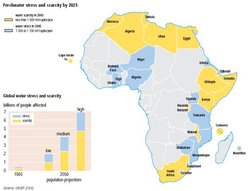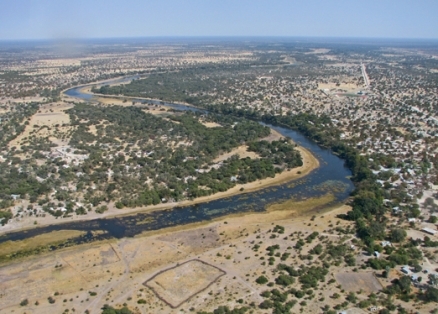Southern Africa freshwater resources
Southern Africa is vulnerable to environmental change due to its limited water resources. Poverty is widespread, with large numbers of its people living on less than a dollar a day, HIV/AIDS is a growing problem in many of the countries and its population is largely rural and heavily dependent on agriculture.
This sub-region has 12 major internationally shared river basins, of which the four largest basins are the Zambezi, Orange, Okavango and Limpopo river basins. Surface runoff in the northern and eastern parts is available in sufficient quantities throughout the year. In the south-western part it only occurs with extreme episodic rainfall events. Under such conditions, people rely largely on dams and groundwater resources. Major groundwater resources are found in the Kalahari-Etosha, Karoo, Cape Fold Belt, East Kalahari Precambrian Belt and the coastal basins of Mozambique and Tanzania. The region has experienced floods in the northeast and episodes of severe and prolonged droughts in other places.
Contents
Endowments and opportunities
Southern Africa’s freshwater resources (Southern Africa freshwater resources) are critical aspects of local livelihoods and a central component of many economic activities. Several are also recognized as globally significant from a biological diversity perspective. These include the Okavango Delta, the St. Lucia Wetlands and Lake Malawi.
Lake Malawi is the third largest lake in Africa. It is 560 kilometers (km) long, 75 km wide (at maximum width), has a maximum depth of 700 meters (m) at its western shore and a mean depth of about 290 m, with lake capacity (volume) estimated at 8,400 km3. It is an important resource for people in Tanzania, Malawi and Mozambique, who rely on it for potable water, food, irrigation and hydropower. It is also important for navigation, transportation and tourism, and supports both subsistence and commercial fisheries. It has the largest number of fish species of any lake in the world, estimated at more than 600, of which half have been identified. Many of these are endemic.
To meet the demand of the growing population, solutions in the past mainly focused on the supply side of resource management. As a result, Southern Africa has a high concentration of dams and inter-basin transfer schemes. Yet, cheaper and readily accessible solutions have proven to be possible and significant strides have been made towards the development of infrastructure for water supply and sanitation services. Among the adopted measures are improved maintenance and efficiency of urban water distribution networks, and improvement of sewage treatment and disposal facilities. Various tools are deployed to control the impacts of discharges on water quality, such as subsidies per unit of pollution emission abatement, waste charges, and penalties for pollution, following the "polluter pays principle". Irrigated agriculture places the highest demand on water and many countries are introducing more efficient, cost-effective and sustainable water demand management (WDM) measures aimed at controlling demand to conserve water. Namibia, for instance, has been successful in implementing a wide range of WDM measures including plastic covers over the soil to reduce evaporation, block-tariff systems in the urban sector to curb excessive water use, leak detection programs and public campaigns to educate people about the role of water.
Challenges faced in realizing development opportunities
 Figure 2: Freshwater stress and scarcity by 2025. (Source: UNEP 2002)
Figure 2: Freshwater stress and scarcity by 2025. (Source: UNEP 2002) Future projections for Southern Africa for 2025 suggest that water availability per person will sharply decrease for most countries. Southern Africa is among the few regions in the world for which most global climate models agree upon an increase in aridity in the future and hence a further lowering of water availability for livelihoods. In particular, the projection looks bleak for Malawi and South Africa. In addition, Lesotho, Tanzania and Zimbabwe are expected to experience water stress by 2025, while Swaziland is likely to experience water quality and availability problems in the dry season. The sub-region has experienced floods in the northeast and episodes of severe and prolonged droughts in other places. Repeated droughts affect freshwater availability and make the sub-region prone to soil erosion, which in turn affects water quality through siltation. The extreme amounts of soils transported to the coast especially impact the mangrove forests, causing asphyxiation of the buried roots.
Over-abstraction of surface water resources has caused significant changes in the flow regimes and water quality of many rivers, leading to negative impacts on aquatic biota and subsequent loss of ecological function and health. For example, the building of the Kariba Dam altered the hydrological regime of the Zambezi River and changed the Marrameu floodplain to a dry, bushy area prone to fire. Additional threats to the remaining Zambezi basin wetlands include reduced flows caused by droughts and water abstractions, aquatic weed infestation, pesticides (especially DDT), infrastructure development like dams, overuse of resources due to human pressures, uncontrolled fires, pollution and deforestation.
Water pollution, especially from agricultural drainage and wash-off, urban wash-off and effluent return flows, industries, mining, and areas with insufficient sanitation services, is increasing. Pollution of groundwater resources is of particular concern because it is costly and time-consuming to rehabilitate. Water quality management should therefore form an integral part of a strategy for water resource management. Invasive alien species, and in particular Eichhornia crassipes (water hyacinth), threatens many freshwater bodies.
Strategies to improve development opportunities
There has been good progress in water sector reforms since the late 1990s, with an increasingly integrated approach to water resource management (Improving freshwater management in Africa) (surface water, groundwater, socioeconomic and other issues dealt with in an integrated manner). The reforms, which include the setting up of new institutions with new functions, responsibilities, legislation and guidelines for water resource development and management, take place at different paces and at different scales.
Most countries have established catchment management institutions with specified powers and responsibilities. Transboundary cooperation on water matters takes place within the framework of the [[Protocol on Shared Watercourses in the Protocol on Shared Watercourses. River Basin Commissions have been established in all of the four largest river basins, with the most recent developments being the establishment of the Zambezi Watercourse Commission in 2004 and the Limpopo Watercourse Commission in 2003.
Capacity enhancement programs at various academic and institutional levels, such as WaterNet and the Global Water Partnership (GWP), support and facilitate the adoption of integrated water resources management (IWRM) approaches. Water-related data and information are increasingly compiled according to hydrologic boundaries. Opportunities for further work are in the areas of climate variability and ../151215/index.html change]], water pollution, groundwater recharge and environmental flow.
Many Southern African countries have embarked on cost-recovery approaches or on enhancing private-sector participation in providing water to urban and rural areas at various degrees of recovery rates. About 45 percent of Zambia’s population of approximately ten million live in urban areas, of which 50 to 70 percent live in peri-urban areas. One of the major aims of water sector reforms that the Zambian government has been implementing since 1994, was to alleviate the pressure on the water supply and sanitation situation. Presently, the majority of the water supply and sanitation service provision schemes in low-income peri-urban areas have been commercialized and responsibilities have been devolved to local authorities and the private sector. A Devolution Trust Fund (DTF) was established in 2001 by Zambia’s National Water Supply and Sanitation Council under a provision in the Water Supply and Sanitation Act of 1997 to improve the service provision in the low-income peri-urban areas. The DTF assists Commercial Water Utilities in expanding their services in these areas and also the establishment of water kiosks. These are low-cost public outlets run by private water vendors who are linked by contract to professional operators of the entire system. The kiosks can achieve an acceptable service standard and have other advantages, such as improving quality of available water, if they are linked to the main water network. The DTF is perceived by all stakeholders as an appropriate instrument to alleviate the pressure on the water supply and sanitation situation in peri-urban areas. It can contribute to realizing the target of halving the proportion of people with no access to clean water and proper sanitation by 2015. This describes an initiative that was undertaken to improve water and sanitation service provision to poor urban and rural communities.
Other measures that are possible for solving the problem of financing water projects in developing countries, besides donor support, include the encouragement of international commercial lending, the promotion of private investment and operations, and the recognition and support of community initiatives and non-governmental organizations by providing them with the resources necessary to perform their important role.
Further Reading
- Chenje, M. (ed. 2000). State of the Environment Zambezi Basin 2000. Southern African Development Community/IUCN – The World Conservation Union / Zambezi River Authority / Southern African Research and Documentation Centre, Maseru/Lusaka/Harare. ISBN: 1779100094
- Chiuta, T.M., Johnson, P. and Hirji, R., 2002. Chapter 2: Water Resources and the Economy. In Defining and Mainstreaming Environmental Sustainability in Water Resources Management in Southern Africa, pp 21-52. Southern African Development Community, IUCN – The World Conservation Union, Southern African Research and Documentation Centre and World Bank, Maseru/Harare/Washington, D.C.
- DWAF, 2004. National Water Resource Strategy: Our Blue Print for Survival, First Edition – September 2004. Department of Water Affairs and Forestry, Pretoria.
- DWC, 2003. Climate changes the water rules – How water managers can cope with today’s climate variability and tomorrow’s climate change. Dialogue on Water and Climate, Delft.
- ECA, 2000. Transboundary River/Lake Basin Water Development in Africa: Prospects, Problems, and Achievements. ECA/RCID/052/00. United Nations Economic Commission for Africa, Addis Ababa.
- GTZ, 2004. Sharing the experience on regulation in the water sector, SOWAS - working group on regulation and PSP in Sub Saharan Africa. German Technical Cooperation Agency, Lusaka.
- Hirji, R., Johnson, P., Maro, P. and Matiza Chiuta, T. (eds. 2002). Defining and Mainstreaming Environmental Sustainability in Water Resources Management in Southern Africa. Southern African Development Community, IUCN – The World Conservation Union, Southern African Research and Documentation Centre and World Bank, Maseru/Harare/Washington, D.C.
- IPCC, 2001. Climate Change 2001: Synthesis Report. A Contribution of Working Groups I, II, and III to the Third Assessment Report of the Intergovernmental Panel on Climate Change (eds.Watson, R.T. and the Core Writing Team). Cambridge University Press, Cambridge. ISBN: 0521807700
- S & E Bulletin, 1999. Biodiversity in Lake Malawi. The Science and the Environment Bulletin, March/April.
- Southern African Development Community (SADC) Homepage
- Schuijt, K., 2002. Land and Water Use of Wetlands in Africa: Economic values of African wetlands. IIASA Interim Report IR-02-063. International Institute for Applied Systems Analysis, Austria.
- UNEP, 2006. Africa Environment Outlook 2
|
|
| Disclaimer: This article is taken wholly from, or contains information that was originally published by, the United Nations Environment Programme. Topic editors and authors for the Encyclopedia of Earth may have edited its content or added new information. The use of information from the United Nations Environment Programme should not be construed as support for or endorsement by that organization for any new information added by EoE personnel, or for any editing of the original content. |


